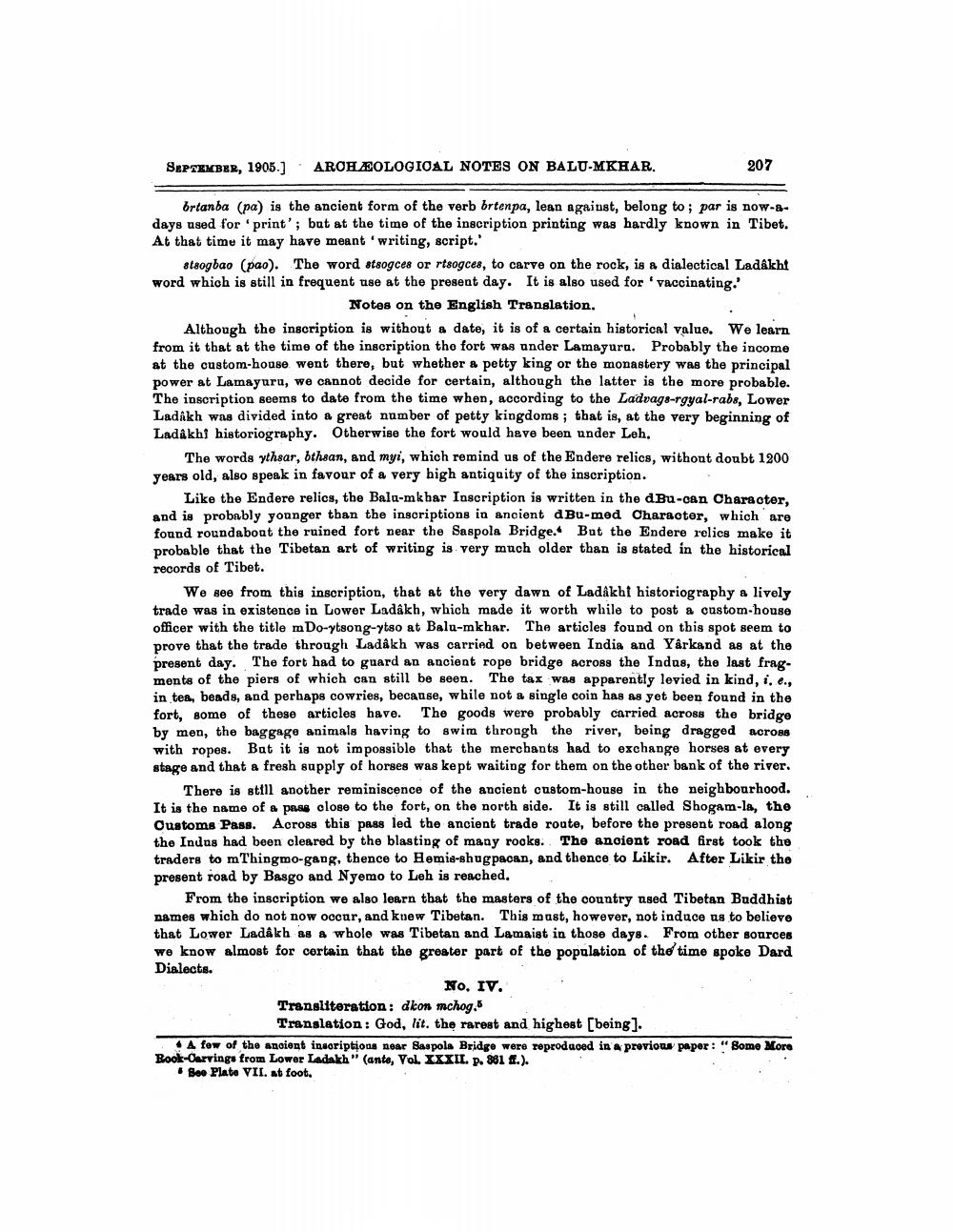________________
SEPTEMBER, 1905.] · ARCHÆOLOGICAL NOTES ON BALU-MKHAR.
207
brtanba (pa) is the ancient form of the verb brtenpa, lean agaiust, belong to ; par is now-&days used for 'print'; but at the time of the inscription printing was hardly known in Tibet. At that time it may have meant 'writing, script.'
stsogbao (pao). The word stsogces or rtsogces, to carve on the rock, is a dialectical Ladakht word which is still in frequent use at the present day. It is also used for vaccinating.'
Notes on the English Translation, Although the inscription is without a date, it is of a certain historical value. We learn from it that at the time of the inscription the fort was under Lamayura. Probably the income at the custom-house went there, but whether a petty king or the monastery was the principal power at Lamayuru, we cannot decide for certain, although the latter is the more probable. The inscription seems to date from the time when, according to the Ladvags-rgyal-rabs, Lower Ladakh was divided into a great number of petty kingdoms; that is, at the very beginning of Ladakhi historiography. Otherwise the fort would heve been under Leh.
The words ythsar, bthsan, and myi, which remind us of the Endere relics, without doubt 1200 years old, also speak in favour of a very high antiquity of the inscription.
Like the Endere relics, the Bala-mkbar Inscription is written in the dBu-oan Character, and is probably younger than the inscriptions in ancient dBu-med Character, which are found roundabout the ruined fort near the Saspola Bridge. But the Endere relics make it probable that the Tibetan art of writing is very much older than is stated in the historical records of Tibet.
We see from this inscription, that at the very dawn of Ladakht historiography a lively trade was in existence in Lower Ladakh, which made it worth while to post a custom-house officer with the title m Do-ytsong-ytso at Balu-mkhar. The articles found on this spot seem to prove that the trade through Ladakh was carried on between India and Yarkand as at the present day. The fort had to guard an ancient rope bridge across the Indus, the last fragments of the piers of which can still be seen. The tax was apparently levied in kind, i.e., in tea, beads, and perhaps cowries, because, while not a single coin has as yet been found in the fort, some of these articles have. The goods were probably carried across the bridge by men, the baggage animals having to swim through the river, being dragged across with ropes. Bat it is not impossible that the merchants had to exchange horses at every stage and that a fresh supply of horses was kept waiting for them on the other bank of the river.
There is still another reminiscence of the ancient custom-house in the neighbourhood. It is the name of a pass close to the fort, on the north side. It is still called Shogam-la, the Oustoms Pass. Across this pass led the ancient trade route, before the present road along the Indus had been cleared by the blasting of many rocks. The ancient road first took the traders to mThingmo-gang, thence to Hemis-shugpacan, and thence to Likir. After Likir the present road by Basgo and Nyemo to Leh is reached.
From the inscription we also learn that the masters of the country ased Tibetan Buddhist names which do not now occur, and knew Tibetan. This must, however, not induce us to believe that Lower Ladakh as a whole was Tibetan and Lamaist in those days. From other sources we know almost for cortain that the greater part of the population of the time spoke Dard Dialects.
No. IV. Transliteration: dkon mchog.
Translation: God, lit. the rarest and highest [being]. # A few of the ancient insoriptions near Saspola Bridge were reproduced in a previous paper: "Some More Book-Carvinge from Lower Ladakh" (ante, Vol. XXXII. p. 361 ff.).
• Soo Plata VII. at foot.




